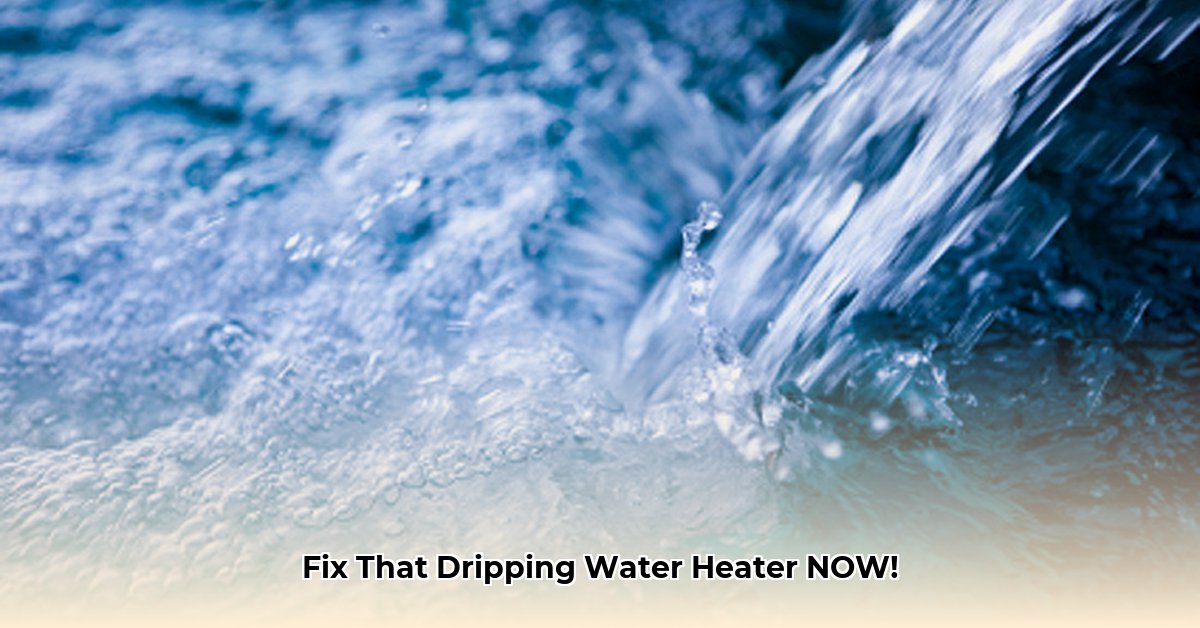That dripping water heater relief valve can be alarming, but addressing it promptly can prevent bigger problems like expensive repairs and water damage. This guide walks you through diagnosing the leak’s cause, from high pressure to a faulty valve, offers DIY fixes, and advises when to call a plumber. For more water heater troubleshooting tips, check out this helpful resource: water heater issues. Let’s get started to stop the leak and keep your water heater running smoothly and efficiently.
Understanding Water Heater Release Valve Leaks
Discovering water dripping from your water heater’s relief valve can be concerning, but it’s often a fixable issue. Ignoring the problem, however, can lead to significant damage and costly repairs. Let’s explore how to address this common plumbing issue effectively, ensuring safety and longevity for your water heating system.
Identifying the Leak Source and Potential Causes
First, confirm the water source is indeed the relief valve, also known as the Temperature and Pressure Relief (TPR) valve. It’s typically found near the top or upper side of your water heater, featuring a small discharge pipe extending downwards and a test lever. Determine the leak’s severity—a minor drip is more manageable than a constant stream, which may require immediate professional attention.
Several factors can cause a relief valve to leak, each indicating a specific issue within your system:
- Excessive Water Pressure: High water pressure in your home’s plumbing system can exceed the valve’s safety threshold, forcing it to release water to prevent tank damage. This is akin to overfilling a water balloon. Normal water pressure should be between 40 and 80 PSI (pounds per square inch).
- Thermal Expansion: As water heats, it expands. If a closed plumbing system doesn’t have an expansion tank, the increasing pressure can trigger the relief valve.
- Mineral Buildup (Sediment): Over time, mineral deposits and sediment can accumulate at the bottom of the tank. This buildup can cause the water heater to work harder, leading to overheating and increased pressure, as well as directly interfering with the valve’s ability to seal properly.
- Valve Deterioration: Mechanical parts within the TPR valve can corrode or wear out over time, compromising its ability to seal correctly. This can lead to a continuous drip or leak, even when pressure and temperature are within normal limits.
- Loose Connections: Sometimes, a simple loose connection at the valve’s inlet or outlet pipe can be the culprit, often easily fixed with a wrench. Look for water seepage around these connections.
- Overheating: A malfunctioning thermostat can cause the water to overheat, leading to excessive pressure and triggering the T&P valve.
- Faulty Expansion Tank: If your system has an expansion tank, it could be waterlogged or improperly sized, failing to absorb excess pressure from thermal expansion.
Prioritizing Safety: Turning Off Power and Water
Before inspecting anything, ensure safety by turning off the power to your water heater at the circuit breaker (for electric models) or setting the gas control valve to “Pilot” (for gas models). Shut off the cold water supply valve located on the inlet pipe to the water heater. These steps are essential to prevent electrical shocks, scalding, and further water leakage, a non-negotiable safety measure.
Step-by-Step Troubleshooting Guide
Follow these steps to diagnose and address the leak:
- Visual Examination: Carefully inspect the valve for rust, cracks, or any visible damage, which is easier to spot with the water and power shut off. Pay close attention to the discharge pipe for signs of dripping or corrosion.
- Water Pressure Test: Attach a pressure gauge to an outside faucet or a laundry tub faucet to measure your home’s water pressure. If it exceeds 80 PSI, consider installing a pressure-reducing valve on your main water supply line.
- Gentle Tightening of Connections: If loose connections are visible, gently tighten them with a wrench, avoiding over-tightening, which can damage the fittings. Use two wrenches – one to hold the valve body and another to tighten the connection.
- Valve Test: Carefully lift the test lever on the TPR valve. Hot water should flow freely from the discharge pipe. Release the lever and ensure the valve reseals tightly, stopping the flow of water. If the valve continues to drip or doesn’t reseal properly, it likely needs replacement. Caution: Hot water will be discharged. Ensure the discharge pipe is directed safely.
- Expansion Tank Check: If you have an expansion tank, check its air pressure. The pressure should match your home’s water pressure (e.g., 60 PSI). You can check the pressure using a tire pressure gauge on the Schrader valve located on the tank. If the tank is waterlogged (full of water) or the pressure is incorrect, it might need to be recharged or replaced.
- Temperature Adjustment: Check the water heater’s thermostat setting. A setting of 120°F is generally recommended to prevent scalding and conserve energy. Lowering the temperature can reduce pressure and prevent the valve from activating unnecessarily.
- Water Heater Flush (If Necessary): Sediment buildup can affect performance; consult your water heater’s manual for safe and effective flushing instructions. Typically, this involves draining the tank through a hose connected to the drain valve near the bottom.
DIY Repairs vs. Professional Plumbing Services
While minor leaks from loose connections might be DIY-fixable, it’s crucial to consult a plumber if unsure or if the leak is substantial. Attempting to fix complex issues without proper knowledge can worsen the problem, leading to costly repairs and potential hazards. Replacing a TPR valve or installing an expansion tank are best left to qualified professionals.
Recognizing When to Call a Plumber
Seek professional help in the following situations:
- Significant Leaks: Any leak beyond a slow drip warrants a plumber’s expertise.
- Suspected Valve Failure: If testing the valve reveals it doesn’t reseal or is visibly damaged, professional assistance is likely needed.
- Expansion Tank Issues: Problems with the expansion tank, such as waterlogging or incorrect pressure, require professional diagnosis and repair.
- Unusual Noises: Rumbling or banging noises coming from the water heater can indicate a buildup of sediment or other internal problems that require professional attention.
- Personal Discomfort: When plumbing tasks are beyond your comfort level, it is always best to consult an expert.
Preventative Maintenance Checklist
Regular maintenance is the key to preventing future problems. Incorporate these steps:
- Annual Inspections: Check the valve yearly for leaks or corrosion to prevent future issues. A plumber can perform a more thorough inspection of the entire water heater system.
- Water Pressure Monitoring: Ensure your home’s water pressure remains within the recommended range (40-80 PSI). Install a pressure-reducing valve if necessary.
- Regular Flushing: Periodically remove sediment buildup as recommended in your water heater’s manual to maintain smooth operation. The frequency depends on the water hardness in your area; typically, once a year is sufficient.
- T&P Valve Testing: Test the T&P valve at least once a year to ensure it’s functioning correctly.
- Expansion Tank Maintenance: Check the air pressure in your expansion tank annually and recharge it if necessary.
Understanding the Risks – A Quick Overview
| Component | Potential Problem | Likelihood of Problem | Impact of Failure | How Serious? | Ways to Reduce the Risk |
|---|---|---|---|---|---|
| Water Heater Relief Valve | Leaking | Moderate | Moderate | Moderate | Regular inspection, timely replacement |
| Expansion Tank | Pressure regulation failure | Moderate | High | High | Regular inspection, timely replacement, proper sizing |
| Thermostat | Malfunction, overheating | Low to Moderate | High | High | Regular inspection, proper setting |
| Pressure Reducing Valve | Failure, high water pressure | Low to Moderate | High | High | Regular inspection, timely replacement |
Addressing a leaking water heater relief valve promptly is essential to prevent water damage and ensure safety. If unsure about any step, consult a plumber. It’s always better to err on the side of caution.
Preventing Water Heater Relief Valve Leaks from Excessive Pressure
Key Takeaways:
- High water pressure is a common factor for water heater relief valve leaks.
- Sediment buildup can restrict valve operation, contributing to leaks.
- Regular maintenance significantly minimizes leak risk.
- Knowing when professional assistance is crucial helps prevent major damage.
Understanding the Pressure Relief Valve (PRV)
Your water heater’s pressure relief valve (PRV), more accurately referred to as the Temperature and Pressure Relief (TPR) valve, acts as a crucial safety mechanism, preventing tank rupture from excess pressure or temperature, functioning as a pressure safety valve and a thermal safety valve. A leaking PRV signifies a problem that requires attention.
Recognizing PRV Leaks
A leaking PRV often presents as a steady drip or slight stream from the valve or nearby connections, with leaks potentially escalating quickly. Look for water stains, mineral deposits, or corrosion around the valve and discharge pipe. Sometimes, the leak is only noticeable when the water heater is actively heating water.
Common Causes: How to Prevent Water Heater Relief Valve Leaks from Excessive Pressure
Several factors lead to PRV leaks. Here are the most
- How to Stop Apps From Running in the Background to Boost Your - December 1, 2025
- How To Move Apps On Your Droid For Better Organization - November 30, 2025
- How to Move Apps on Android for Better Organization - November 29, 2025










